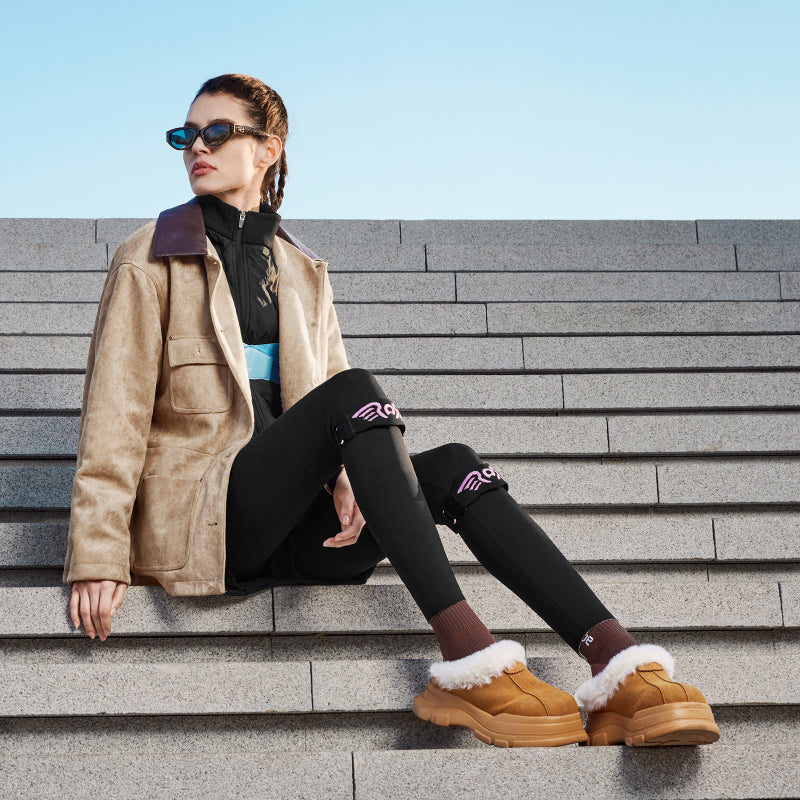Knee braces play a crucial role in injury prevention, pain relief, and rehabilitation. Whether you're an athlete, recovering from knee surgery, or managing chronic joint conditions, the right knee brace can help enhance stability and movement.
This article explores the scientific research, expert recommendations, and aoFIT’s latest innovations to help you understand how knee braces support running, improve sleep, and prevent injuries.
How Knee Braces Work: Evidence-Based Benefits
Clinical Research Highlights
Multiple studies have shown that knee braces significantly impact joint health by improving stability, reducing pain, and aiding post-surgical recovery.
✅ Increased Joint Stability: According to the American College of Sports Medicine (ACSM), knee braces can reduce shear force on the knee joint by 25-30%, which lowers the risk of anterior cruciate ligament (ACL) injuries.
✅ Pain Reduction in Knee Osteoarthritis: A 2022 study in the Journal of Orthopedic Research (JOR) found that compression knee braces help reduce pain by 40% and improve mobility by 30% in individuals with knee osteoarthritis.
✅ Faster Recovery After Knee Surgery: Research involving 500 post-surgery patients showed that wearing a knee brace reduced rehabilitation time by 15-20%, supporting improved knee function.
🔹 Expert Opinion:
Dr. James Andrews, an orthopedic surgeon specializing in sports medicine, states:
"Knee braces are valuable for individuals recovering from injuries and those engaged in high-impact activities. They provide additional support and reduce strain on the knee, helping to prevent long-term joint issues."
🔹 aoFIT’s Knee Brace Innovations:
- Engineered Compression Design: Supports movement while enhancing blood flow.
- Targeted Stability Features: Provides reinforcement for ligament and joint protection.
- Breathable, Adaptive Fit: Designed for long-term wear without discomfort.
Using a Knee Brace While Running: Injury Prevention & Performance
Running places high-impact stress on the knee joint, with forces reaching 3-5 times body weight during each foot strike. For long-distance runners, sprinters, and individuals with previous knee injuries, using a knee brace can reduce injury risks and improve running mechanics.
How Knee Braces Support Runners
📌 Shock Absorption: Distributes impact forces and reduces stress on the knee joint by up to 25%.
📌 Patella Alignment: Stabilizes the kneecap, reducing Runner’s Knee (Patellofemoral Pain Syndrome, PFPS).
📌 Ligament Protection: Limits excessive joint movement, lowering the risk of ACL and meniscus injuries.
Scientific Support
🔹 2021 Sports Medicine Journal Study:
- Runners wearing knee braces had a 23% lower incidence of patellar pain syndrome (PFPS).
- Knee braces helped reduce patellofemoral joint stress by 15%, decreasing the likelihood of overuse injuries.
aoFIT’s Running Knee Brace Features
✔ Lightweight, Flexible Structure: Maintains freedom of movement while offering support.
✔ Non-Slip Silicone Grip: Prevents shifting during high-intensity activity.
✔ Moisture-Wicking Fabric: Keeps the knee cool and dry, even during long-distance runs.
Tip: Combine knee brace use with strength training and proper running techniques to optimize joint protection.
Choosing the Right Knee Brace for Your Needs
aoFIT offers a variety of knee braces designed for different activity levels and recovery needs. Selecting the right brace depends on the level of support required and personal comfort preferences.
1. Understanding Support Levels
| Support Type | Best For | aoFIT Recommendation |
|---|---|---|
| Mild Compression | General discomfort, minor swelling | aoFIT Flex Sleeve |
| Moderate Support | Running, ligament protection | aoFIT Performance Brace |
| Maximum Stability | Post-surgery recovery, arthritis | aoFIT Hinged Knee Brace |
2. Fit & Comfort Considerations
- For active use: Opt for a secure, breathable design that stays in place.
- For nighttime support: Choose padded materials to ensure extended wear comfort.
- For rehabilitation: Look for adjustable straps that allow controlled compression.
Frequently Asked Questions (FAQs)
Can I wear a knee brace all day?
Yes, but ensure that it provides the correct level of support and take breaks to avoid over-reliance on external stability.
How tight should a knee brace be?
It should feel snug but not overly tight—enough to provide compression while maintaining proper circulation.
Is it okay to sleep with a knee brace on?
Yes, especially for arthritis, post-surgical recovery, or nighttime discomfort. Choose a soft, flexible brace for optimal comfort.
Do knee braces help with arthritis?
Yes! Clinical studies show that knee braces can reduce arthritis pain by 40% and improve mobility.
Should I wear a knee brace before or after running?
Both! Wearing a knee brace before running supports alignment, while after running it helps with recovery and inflammation control.
Do knee braces weaken muscles?
No, as long as they are used alongside strength training to maintain natural joint stability.
Final Thoughts: Why aoFIT Knee Braces Stand Out
A well-designed knee brace can prevent injuries, reduce pain, and support movement. aoFIT integrates biomechanically engineered designs with targeted support features, making them a reliable choice for:
✅ Athletes seeking injury prevention
✅ Individuals recovering from knee surgery
✅ People with chronic joint conditions
Explore aoFIT’s advanced knee brace collection today and find the perfect fit for your lifestyle!





